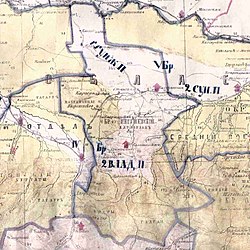
Vladikavkaz, formerly known as Ordzhonikidze (Орджоники́дзе) and also known as Dzaudzhikau (Дзауджикау), is the capital city of North Ossetia-Alania, Russia. It is located in the southeast of the republic at the foothills of the Caucasus, situated on the Terek River. The city's population was 295,830 as of the 2021 Census. As a result, Vladikavkaz is one of the most populous cities in the North Caucasus region.
Yalkharoy is a rural locality in Urus-Martanovsky District of the Republic of Chechnya, Russia.
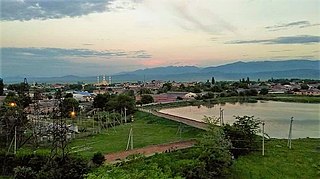
Achkhoy-Martan is a town and the administrative center of Achkhoy-Martanovsky District, Chechnya.
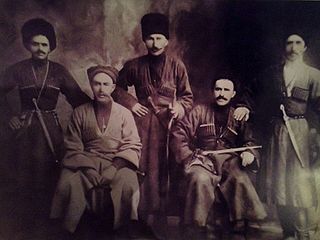
The Orstkhoy, historically commonly known under their exonyms: Karabulaks, Balsu, Baloy, are a historical ethnoterritorial society among the Chechen and Ingush peoples. Their homeland is in the upper reaches of the Assa and Fortanga rivers in the historical region of Orstkhoy-Mokhk. In the tradition of the Chechen ethno-hierarchy, it is considered one of the nine historical Chechen tukkhums, in the Ingush tradition as one of the seven historical Ingush shahars.
Galashki is a rural locality in Sunzhensky District of the Republic of Ingushetia, Russia, located on the left bank of the Sunzha River near the border with the Republic of North Ossetia–Alania. Its population was about 9,000 people in 2009. Galashki forms the municipality of the rural settlement of Galashki as the only settlement in its composition.
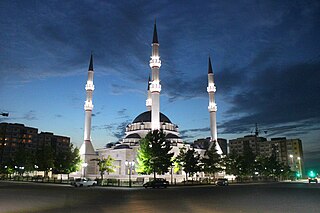
Kurchaloy is a town and the administrative center of Kurchaloyevsky District, Chechnya. Population: 22,723 (2010 Census); 20,857 (2002 Census);
Galanchozh, formerly Akhbosoy, is a non-residential rural locality in Urus-Martanovsky District of the Republic of Chechnya, Russia.

The Dzherakh, also spelled Jerakh, historically also known as Erokhan people, were a historical Ingush ethnoterritorial society, today a tribal organization/clan (teip), that was formed in the Dzheyrakhin gorge, as well as in the area of the lower reaches of the Armkhi River and the upper reaches of the Terek River.
Loamaro — the name of the inhabitants of the mountains in Chechnya and Ingushetia. Loamaro consists of loam (mountain) and the suffix -(a)ro. The ethnonym is literally translated from the Ingush and Chechen language as "mountaineer".
Arshty is a rural locality in Sunzhensky District of the Republic of Ingushetia, Russia, located on left bank of the river Arshtynka near the border with the Republic of Chechnya. It forms the municipality of the rural settlement of Arshty as the only settlement in its composition.
Muzhichi is a rural locality in Sunzhensky District of the Republic of Ingushetia, Russia, located on the left bank of the Sunzha River near the border with the Republic of North Ossetia–Alania. It forms the municipality of the rural settlement of Muzhichi as the only settlement in its composition.

Yandare is a rural locality in Nazranovsky District of the Republic of Ingushetia, Russia. It forms the municipality of the rural settlement of Yandare as the only settlement in its composition.
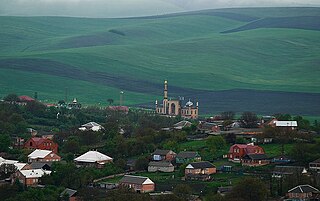
Ekazhevo is a rural locality in Nazranovsky District of the Republic of Ingushetia, Russia. It forms the municipality of the rural settlement of Ekazhevo as the only settlement in its composition.

Barsuki is a rural locality in Nazranovsky District of the Republic of Ingushetia, Russia. It forms the municipality of the rural settlement of Barsuki as the only settlement in its composition.

Plievo is a rural locality in Nazranovsky District of the Republic of Ingushetia, Russia. It forms the municipality of the rural settlement of Plievo as the only settlement in its composition.

Surkhakhi is a rural locality in Nazranovsky District of the Republic of Ingushetia, Russia. It forms the municipality of the rural settlement of Surkhakhi as the only settlement in its composition.
Dattykh is a rural locality in Sunzhensky District of the Republic of Ingushetia, Russia, located on the left bank of the river Fortanga. It forms the municipality of the rural settlement of Dattykh as the only settlement in its composition.

Fortanga historically sometimes referred as Balsu, is a river in North Caucasus that flows in Ingushetia and Chechnya. The length of the river is 69 km, the basin area is 526 km2.
Khay is a non-residential rural locality in Achkhoy-Martanovsky District of the Republic of Chechnya, Russia.
Psedakh is a rural locality in the Malgobeksky District of the Republic of Ingushetia, Russia. It forms the municipality of the rural settlement of Psedakh as the only settlement in its composition.







